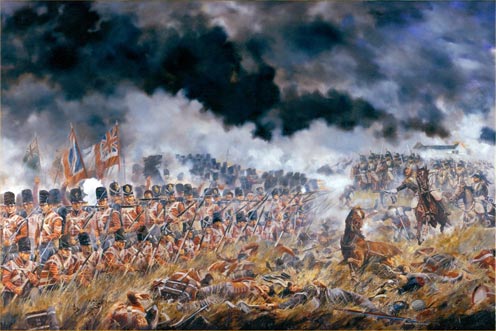
"The 33rd (or 1st Yorkshire West Riding) Regiment at the Battle of Waterloo"
Ref: DR013
by David Rowlands
Image Size: 58 x 38cm
18 June 1815: At Waterloo the 33rd took up a position with Halkett's 5th Brigade in the right centre of the British line. During the day they withstood the French artillery bombardment, but as that fire slackened, the order "Prepare to receive cavalry" was heard as wave after wave of French cuirassiers, dragoons and lancers advanced towards them up the slope. The redcoats formed squares; the front rank knelt, the butt end of their muskets resting on the ground, their bayonets fixed. The second rank crouched, while the third and fourth ranks stood ready to fire. When the densely packed horsemen were within thirty yards, they opened fire and their musket balls crashed into Ney's cavalry. Riders and their mounts tumbled into heaps just beyond bayonet-reach of the kneeling front ranks. French horsemen who rode around the squares of British infantry suffered a similar fate on each side.
The 33rd fought off four successive cavalry charges, each one resulting in heaps of dead and dying men and horses littered in front of the squares. In the intervals between these attacks, the French artillery took its toll on the British infantry. Within the squares it was impossible for a man to move a yard without stepping on a wounded comrade, or upon the bodies of the dead. The Duke of Wellington rode up to Halkett, who said, "My Lord, we are dreadfully cut up; can you not relieve us for a little while?"
"Impossible!"
"Very well my Lord, we'll stand until the last man falls."
By 6 pm the French cavalry had been destroyed as a fighting force. The 33rd and the 69th, united to form a single battalion due to their losses, then had to face the final attack by the infantry of Napoleon's Imperial Guard.
The painting shows the 33rd in square, with the burning farm of La Haye Sainte beyond. Inside the single square formed with the remnants of the 69th, the Colours of both regiments can be seen. (The King's Colour of the 69th had been captured by the enemy at Quatre Bras two days earlier).
